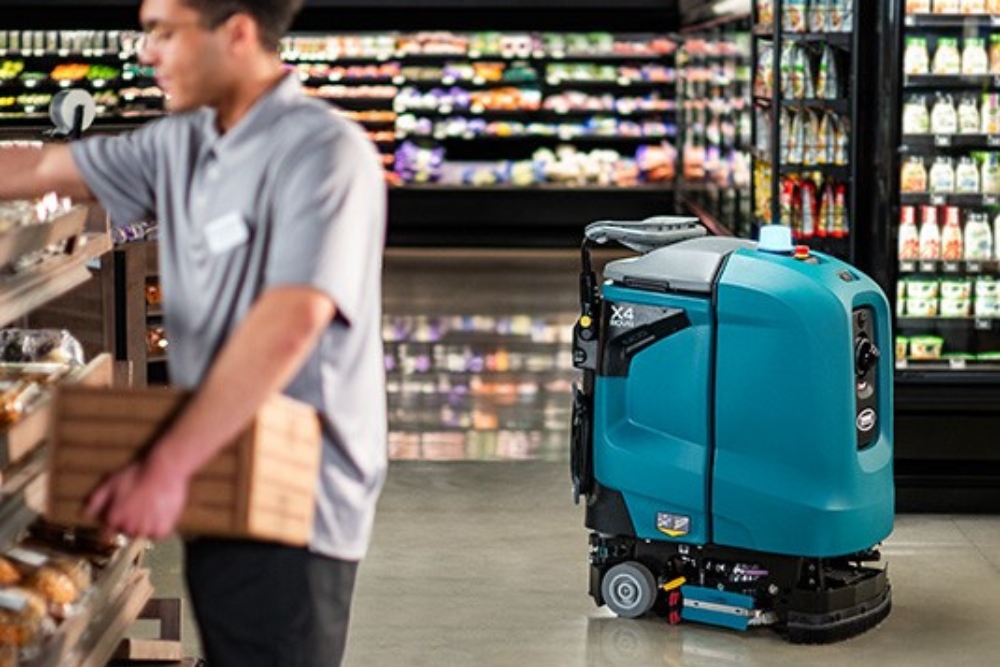Robotics in cleaning have moved from a futuristic idea into everyday operations across industries. From warehouses and schools to retail and healthcare facilities, autonomous cleaning is gaining traction fast with over half-a-million robotic cleaning systems projected to be in use by 2030.

Amid this rapid adoption, facility teams are finding that making robotics work for them requires more than just purchasing the latest tech—it’s about making informed, practical decisions that fit their specific environments. Whether in retail corridors or hospital wings, the true value of autonomous mobile robots (AMRs) lies in how well they integrate with existing workflows, relieve overburdened staff, and deliver measurable, reliable performance.
Here are field-tested lessons from real-world deployments to help facilities managers and cleaning teams leverage robotics in ways that are both smart and sustainable for the long haul.
Retail Teams: Focus on Consistency and Simplicity
In retail, every square foot matters. With areas like the aisles and stockrooms, cleaning needs to be fast, effective, and replicable. But the reality on the ground is often hectic and decentralized. The right robotics program should reduce complexity, not add to it. For multi-site operations, that means selecting robotic solutions that feature simple, user-friendly controls for frontline employees.
Standardization is also key. Establishing uniform automation protocols across retail locations helps to ensure a consistent level of clean while also streamlining staff training. Many AMRs are also able to track fleet data, log runtime, and flag problem areas—facilitIies managers can use this data to optimize rollout and inform future decisions on cleaning procedures.
Recommendation: Start small. Pilot the rollout in a few stores, gather team feedback, and adjust before expanding. A phased approach reduces friction and fosters buy-in from everyone involved.
Warehouse and Large-Site Teams: Think ROI, Not Just Coverage
Large facilities demand strategic automation—not just more of it. For warehouses and other large sites, the goal is to maximize impact with fewer units.
That starts with evaluating efficiency. Can a single machine cover more ground per charge? Does it reduce manual labor, or make other equipment redundant? Efficiency isn’t just about the machine, either; it’s about the workflow. Facility teams managing vast spaces often find that the best returns come from pairing automation with targeted human support. When workflows are designed around what machines do best coupled with what people do best, productivity improves while keeping operations lean.
Recommendation: Leverage your robotics program as a proof point. Showing innovation in cleaning can raise confidence, especially in customer- or client-facing facilities.
Healthcare Facility Teams: Prioritize Proven Cleanliness
In healthcare settings, cleaning is invariably tied to outcomes. That’s why facilities managers in hospitals, clinics, and long-term care facilities are relying more and more on automation that provides traceable, validated cleaning data—essential components for meeting infection control standards.
Robotics shouldn’t replace existing disinfection routines, but they can reinforce them, especially in non-clinical, high-traffic areas like hallways, lobbies, and cafeterias. Success here depends on thoughtful integration; scheduling clean cycles around patient care, minimizing disruption, and ensuring that machines enhance workflows instead of complicating them.
Recommendation: Look for robotic systems that are auditable, easy to operate, and capable of aligning with broader infection prevention protocols. The primary goal is to extend team capacity without compromising safety.
School Facility Teams: Use Robots to Support (not Replace) Staff
Custodial teams within schools and universities are stretched thin. With strict budgets and limited staff, maintaining high cleanliness standards across classrooms, cafeterias, and gymnasiums is an around-the-clock challenge.
This is precisely where automation can provide real relief. Many facility teams are leveraging robotics to handle repetitive, time-consuming floor-cleaning tasks, freeing up staff to focus on higher-touch areas like restrooms and classrooms. Just as important: involving staff early in the implementation process. This will help foster a sense of inclusion and intention while educating employees on how automation is a tool to make their job easier rather than a threat.
Recommendation: Be intentional about how you frame automation. Successful deployments position robots as helpers that make the job easier, not replacements for valued employees.
Five Cross-Industry Actions Every Facility Team Should Take
Whether you’re managing a hospital wing, a warehouse floor, or retail aisle, certain robotics best practices will always apply across the board.
1. Define the goal first: Adopting automation without a clear purpose can lead to suboptimal equipment usage, disjointed workflows, and lowered morale. Successful implementations begin with a specific problem to solve, whether it’s reducing labor strain, improving consistency, or increasing coverage without increasing headcount.
2. Start small, then scale: Rolling out robotics across an entire property or multiple facilities all at once can be overwhelming for even the most experienced facility teams. A smarter route: Focus on a pilot program, using it as a testing ground for training, workflow integration, and performance benchmarks.
3. Train and empower staff: Though they are approaching ubiquity, cleaning robots still carry preconceived notions that should be dispelled—a strategic deployment can flounder if the team doesn’t understand or trust it. The goal is to make the new technology feel like a natural, helpful extension of their daily work (which it is). When employees feel informed and respected, they’re more likely to adopt and champion change.
4. Use data to guide decisions: Today’s robotics platforms boast detailed usage reports, performance logs, and coverage metrics. Don’t let that data go unused. Facilities managers can use it to optimize cleaning practices, flag problem areas that may need special attention, and prove ROI to stakeholders.
5. Stay flexible: Facility needs are never static. Cleaning needs often shift with changes in occupancy patterns, staffing levels, or space usage. The best robotic systems are the ones that can adapt right alongside with them.
Far from a novelty, robotics are becoming firmly entrenched into the day-to-day operations of modern facilities. But success isn’t just about the hardware, however autonomous and capable it may be. It’s about matching the right technology to the real-world needs of the people doing the work. Success with robotics starts when facility teams get clear on the why, plan the how, and openly involve the people who make it happen.

Seth Rourke is the vice president of global product management at Tennant Co., specializing in leading projects on robotics and automated cleaning technology.
